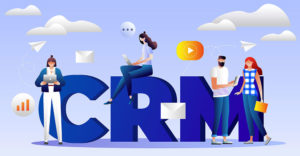
Cyber Monday may be the most visible symbol of the increasing use of e-commerce technology in the retail sector. On just one day, Nov. 30, consumers operating from home or office computers in the U.S. spent US$887 million on Internet purchases. The spending level amounted to a gain of 5 percent versus Cyber Monday of 2008, and it matched the heaviest online spending day on record, which occurred on Dec. 9, 2008.
That level of spending explains why Internet marketing has become such a key component of customer relationship management programs in the U.S. retail trade. However, as important as online marketing is now — and will become in the future — it is not the only worthwhile objective for using CRM in the retail sector.
U.S. retailers are well aware of the significant benefits of using CRM, and most employ some CRM tools, although the degree of usage varies considerably.
Retail CRM: A Mixed Shopping Bag
“Right now, I think it’s a case of leaders and laggards,” Sallie Burnett, president of Customer Insight Group, told CRM Buyer.
“There are a relatively small number of retail leaders who have a fully implemented a CRM program. Most of the others still strongly embrace CRM, but they have failed to maximize the potential,” she said.
“In general, there is widespread use of CRM, but it’s pretty uneven,” noted Chris Fletcher, research director at AMR Research, “and it kind of depends on what retailers mean by ‘CRM.’
“Some use a rewards or a loyalty program,” Fletcher told CRM Buyer. “Others use call centers to help customers solve problems. But only a few have a fully integrated approach to CRM. Mainly, they put in a program on an ad hoc basis to address pain points as they emerge.”
Some retailers have a fully implemented conventional CRM program and have adapted it to new developments such as social networking, Burnett pointed out. Others are comfortable with a traditional program but haven’t yet integrated new media and channels. Still others are at various levels of using bits and pieces of conventional CRM programs.
While there may be degrees of implementation among retailers in using CRM, it appears that few retailers need to be convinced of the value of using such programs.
Customer Focus Gets Priority
Customer satisfaction and retention was a priority strategic goal in the retail sector for three straight years — 2007 through 2009 — according to the National Retail Federation’s industry survey “Retail Horizons.” NRF surveyed 400 retail executives from 153 companies across the full spectrum of the industry.
Two-thirds of survey respondents reported in 2008 that they had implemented customer relationship management programs, and one-third said they planned to do so in 2009.
“The move toward a more customer-centered way of doing business has become mainstream,” the report notes.
Still, there is a significant gap between appreciating CRM as a concept and actually implementing a system that fully utilizes the real potential of CRM and the related tools of e-commerce and information technology.
“For many companies, the transformation is under way toward a more customer-centered, knowledge-based, and integrated way of doing business, but it is still far from completed,” NRF notes in its survey report.
The survey provided “several indications that the implementation of new customer-relevant metrics, appropriate for driving performance in a customer-centered company, still lags at many retail companies,” the report says.
There are several reasons retailers have failed to fully utilize CRM.
“One issue is short and long-term tension,” Janet Murphy, president of Ogden Associates, told CRM Buyer. “To build an effective CRM program is a long-term investment, and yet the retailers want to remain competitive and profitable in the short term, so they have to balance those goals.”
Thus, an outlay for a direct mail campaign that results in a quick boost in sales may divert resources from installing a comprehensive long-term CRM program, for example.
Ogden assisted the NRF in conducting the Retail Horizons survey.
Another problem is coordinating CRM efforts. “Many retailers, especially the traditional brick-and-mortar companies, revert to a silo situation. They may expand to a catalog sales operation or an Internet program, but they set up separate operations for these channels and the channel managers don’t cooperate,” AMR’s Fletcher said.
“They duplicate data collection and never fully exploit the CRM capability of getting a complete customer profile because they don’t integrate the customer data,” he added, “and [they] wind up with a hodge-podge approach.”
Customers Expect More
A subtle but still significant factor is the orientation of the retail company regarding CRM.
“In the past, the emphasis was on merchandising — getting attractive products to sell. Now there is much more attention on getting to know the customer better and orienting the marketing based on customer needs and doing things to retain the customer base. The emergence of the online retailer was a real game-changer in pushing that concept, and the brick-and-mortar retailers had to adapt to that,” Murphy said.
“The online retail channel has changed the customer experience situation,” noted Burnett. “With digital marketing, the customer expectation level is higher. Customers can shop a variety of sources easily. They can get product reviews and information from Web sites and blogs. So, now they expect retailers to provide this kind of support. The whole engagement environment with the customer has changed, and the retailers are beginning to react to it.”
The change in orientation is now working its way back through traditional marketing channels, including the brick-and-mortar physical store component, with increased attention on a more personal — or customer-centric — approach, even with tried-and-true tools such as direct mail campaigns that are now based on more precise knowledge of individual customers.
When CRM first emerged in retail marketing, its scope appeared to be more limited; it formed one aspect of marketing tactics, along with merchandise management, discount selling, heavy newspaper advertising and other selling tools.
The e-commerce tools associated with CRM — such as data collection — pushed the concept into a realm focusing almost exclusively on the associated technologies, noted Burnett.
“That’s why we are now seeing terms like ‘customer-centric,’ which address the whole customer experience aspect of marketing,” she said. The use of technology is simply a means to address the shift in focus to the customer.
With retailers now committed to a more customer-oriented way of doing business, the role of technology will be even more crucial to success. Even at less-than-optimal levels, retailers now spend a considerable amount of their budgets on CRM tools, and that is likely to increase with more attention on customers.
Retailers spend between 3.5 percent and 4.0 percent of sales on marketing, according to NRF. Retail sales in the U.S. amount to $3.67 trillion annually. If expenditures for CRM tools amount to just a fraction of normal retail marketing outlays, that still translates to a huge collective expenditure for retailers and a major opportunity for CRM technology vendors.























































The inherent challenges faced by retailers in adopting CRM are no different than the challenges faced by any sector.